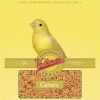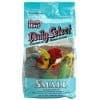Higgins Versele-Laga Intune Natural Hand Feeding Formula For Parrots 10 oz
Original price was: $11.00.$10.00Current price is: $10.00.
6 in stock
This product is available for $8.80 a 12% discount, if it is your first purchase, please register/login here
Description
Feeding Directions Preparation
Before you begin hand feeding your baby birds(s), we recommend you have the following items at your disposal:
- Clean, sanitized mixing bowl for blending the hand feeding powder with water.
- Plastic feeding syringe(s) for delivery of the prepared formula.
- Thermometer for measuring water and mixed formula temperature.
- A heat source such as a brooder to keep baby birds warm after feeding.
- Paper towels and a food-safe disinfectant.
Feeding
Higgins inTune Natural Hand Feeding is easy to prepare and feed but there are a few important steps to follow when preparing the formula:
- Use only filtered water that has been heated to 120F (49C). If unsure of the water quality, boil for a minimum of 10 minutes, and then allow the water to cool to 120F before mixing with the hand feeding powder.
- Follow the Mixing Chart below to determine your bird’s inTune-to-water ratio:
Age (In Days) inTune Water Hatch – 2 days 1 Part 4 – 6 parts 2 – 5 days 1 Part 3 – 4 parts 5 – Weaning 1 Part 1-1/2 to 2 parts Once mixed thoroughly with a spoon, allow the mixture to “rest” until an inserted thermometer reads a temperature of between 102F – 108F. This is the ideal and recommended temperature to begin feeding. Newly hatched to 2 day (24 to 48 hr) old chicks should be fed a “watered” formula, as shown in the Mixing Chart. The formula will separate at this ratio and is a normal occurrence. Blend well prior to each filling of the syringe to ensure adequate delivery of nutrients. A newborn chick requires hydration and water-soluble nutrients more than anything else at this early stage.2 to 5 days old chicks will begin to eat a thicker formula at a ratio of 1 part inTune Hand Feeding to 3 to 4 parts water. The blended formula should have the consistency of baby food or apple sauce.5 days old to the weaning stage, the formula should be mixed at an even thicker ratio (see Mixing Chart) and should be blended to the consistency of a creamy pudding.
- Feed the blended formula with a clean, disinfected syringe, spoon, tube or any other instrument you’re comfortable with. A separate syringe or utensil should be used for each individual baby chick or each incubator. Fill the feeding syringe and be sure to expel any air in the feeding end.
- Always feed the baby bird from the left side of its mouth. This way the syringe is pointed towards the pharynx that leads to the esophagus. If you feed on the right side, the syringe will be pointed toward the trachea and food aspiration can occur. Aspiration can also occur when the baby bird is reluctant to feed or the formula is dispensed before the baby bird’s natural feeding response (see #5 below).
- Feed the blended formula with the baby bird’s natural feeding response (head bobbing up and down rapidly). This is a natural way of feeding and decreases the likelihood of formula being inhaled.
- Feed until the baby bird’s crop is nicely rounded or it refuses any more food. Do not overfeed as the chick could regurgitate its food.
- Each feeding should consist of 8% of 12% of the baby chick’s weight.
- After feeding, wipe any remaining food on an around the beak area. Place baby bird back in a warm area or incubator. Clean and sanitize all utensils and discard any unused blended inTune Hand Feeding formula.
Other Important Feeding Guidelines
- Baby birds need to be fed on a routine schedule. Newly hatched baby birds need to be fed every 2 hours. Their crops should empty or almost empty at this frequency. This will help you to know if the baby bird is getting the right amount of food in between feedings.
- As your baby bird grows, its feeding frequency will decrease from every 2 hours and lengthen slowly out every 6 to 8 hours, depending on age.
- Monitoring weight gain and loss are one of the more proactive ways to ensure your baby birds are thriving and maintaining a healthy development. Baby birds should be weighed every morning to maintain proper weight gains and monitor overall growth.
- If you notice your baby bird’s crop slow down in between feedings or the crop still has food from the prior feeding, take the following steps immediately: (1) Check that the brooding temperature is adequate. Usually, this will be the cause of crop slowdowns. (2) Thin out the formula at a ratio of 1 part inTune to 3 parts water for 24 hours and then slowly return to the normal concentration within the next 24 hours. (3) If after 36 hours there is no noted improvement, consult a professional avian veterinarian immediately.
- We do not recommend the use of a microwave to heat the water or blended formula because microwaves create “hot spots” that burn the chick’s crop. If you are experienced with microwave hand feeding food preparation, then first heat the water in the microwave, then add to the powdered inTune and test the temperature prior to feeding. If reheating blended formula, then do so at no more than 10 to 15 seconds on high per half cup. After heating, stir well to avoid any hot spots and test temperature again.
Storage
inTune Natural Hand Feeding should be stored in a dry, cool area, away from sunlight. Because inTune is free of artificial preservatives, refrigeration or freezing is recommended after opening.
Never reuse blended inTune Natural Hand feeding formula. Always prepare a fresh batch for every feeding.







Reviews
There are no reviews yet